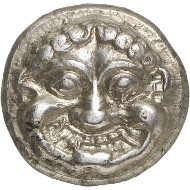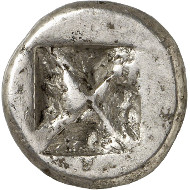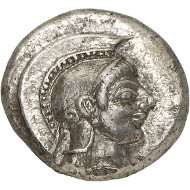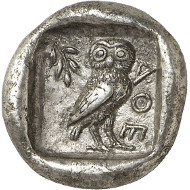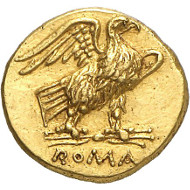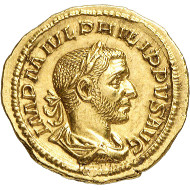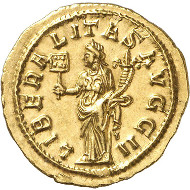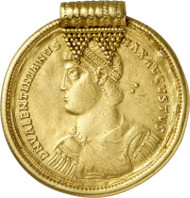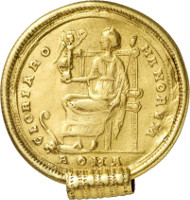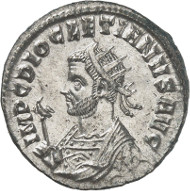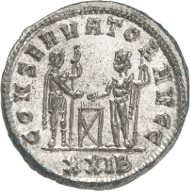04-10-2015 – 08-10-2015
Auction 232-234 Ancient coins
Strong Market for High Quality Ancient Coins
Lot 178: ATHENS (Attica). Wappenmünzen. Didrachm, 545-525/515. Very rare. Extremely fine. Estimate: 15,000,- euros. Hammer price: 42,000,- euros.
All eyes were on the auctioneer when he started to call out the comprehensive series of coins from the city of Athens. Exhibiting a gorgon‘s head on its obverse, already the first item offered for sale, a didrachm, achieved 42,000 euros (estimate: 15,000 euros). The following coins also obtained results in the five-digit region:
- 18,000 euros (didrachm / gorgoneion / estimate: 5,000 euros),
- 15,000 euros (didrachm / horse protome / estimate: 12,000 euros),
- 20,000 euros (didrachm / bovine head / estimate: 15,000 euros),
- 36,000 euros (didrachm / scarab / estimate: 15,000 euros),
- 13,000 euros (drachm / horse hindquarters / estimate: 5,000 euros).
The early tetradrachms, the ‘owls’, on the other hand, ranged in the four-digit region: 6,500 euros (estimate: 5,000 euros), 7,500 euros (estimate: 3,000 euros), 9,500 euros (estimate: 8,000 euros) – we could go on like this. Not a single specimen was unsold. Two amazing results vouched for the fact that smaller denominations are today just as popular as tetradrachms:
Lot 207: ATHENS (Attica). Drachm, 500-490. Rare. Extremely fine. Estimate: 3,000,- euros. Hammer price: 34,000,- euros.
Estimated at 3,000 euros, an Archaic drachm was auctioned off for an impressive 34,000 euros, while a triobol rose to 13,000 euros on a pre-sale estimate of 2,000 euros. Only a decade ago, such results would have been impossible to achieve.
In Auction 232, Gorny & Mosch offered nearly twenty coins from Crete. For Crete, this is a rather large number. The special collectors, therefore, were there to bid for their favorite item. Heavy bidding fights were already caused by the first item on the auction block, a stater from Aptera, which found a new owner for 5,000 euros (estimate: 1,200 euros). Collectors gladly paid 6,500 euros each for an exceptionally well struck stater from Lyttos (estimate: 1,000 euros) and a ‘just’ very fine but extremely rare stater from Praisos featuring the depiction of a helmeted archer (estimate: 800 euros).
Lot 351: ROMAN REPUBLIC. Anonymous. 40 asses, 211-207, Rome. Extremely rare. Extremely fine. Estimate: 25,000,- euros. Hammer price: 55,000,- euros.
Leaving the Greek department, we are now turning to Rome. In this session, Gorny & Mosch offered an extremely rare gold coin struck soon after the monetary reform of 211. Whereas anonymous gold coins in the weight of 60 asses are a comparatively frequently seen on the market, there is only a very small number of specimens known to exist with a nominal value of 40 asses. This found its expression in the hammer price. Realizing 55,000 euros, the coin more than doubled its pre-sale estimate of 25,000 euros.
As we’ve said: Whether gold, silver or bronze, exceptional items are quite easy to sell. So let us present to you one Roman example each:
Lot 467: ROMAN EMPIRE. Philippus I Arabs, 244-249. Aureus, 244-247, Rome. FDC. Estimate: 32,000,- euros. Hammer price: 46,000,- euros.
Gold is represented by an aureus of Philip the Arab, graded FDC; rare and of fine style, it realized 46,000 euros (estimate: 32,000 euros). An antoninianus of Zenobia stands for silver, yet we have to acknowledge that the so-called silver coins hardly contained any silver in those days anymore. Nevertheless, the portrait of the empress of Palmyra, graded very fine to extremely fine, achieved a result of 13,000 euros (estimate: 4,000 euros). Of course, a small follis in very fine is an item of the bronze category. By the estimate of 3,000 euros, everyone could see that this tiny coin was something very special. This sum was related to one of the rarely found coin images which symbolize the Christian policy of Constantine the Great: a labarum standing on a coiling snake. The proud new owner gladly paid 4,600 euros for this specimen.
Lot 524: ROMAN EMPIRE. Valentinian, 364-375. Multiple of 9 solidi, Rome. Unique. Unpublished. Very fine. Estimate: 75,000,- euros. Hammer price: 80,000,- euros.
To conclude this overview of Auction 232, let us mention the medallion of Valentinian I. The multiple of 9 aurei with a contemporary mounting was auctioned off for 80,000 euros (estimate: 75,000 euros).
This multiple equals 9 solidi. It was given as a donative to distinguished dignitaries and officers. The mounting with a granule decoration and a hole suggests that the gorgeous medal was worn on a chain – as a matter of fact, for a longer period of time, as indicated by the traces of wearing. The identity of its wearer cannot be ascertained anymore. Surely, the medal was given to a barbarian ruler as one of Rome’s allies. Giving away a medallion, graced by the portrait of the emperor, was a Roman way of nobilitating the presentee, to the effect that his rule was almost divinely legitimized. What is more, both the influence and the charisma of the emperor were transferred upon the barbarian ruler. Unsurprisingly, therefore, the barbarians used to wear these gold medallions in such a way that everybody could clearly see the portrait of the emperor.
Auction 233 – Ancient Coins and Multiple Lots
The fact that the collectors examined Auction 233 with special care became apparent every time a modestly estimated specimen achieved several times its appraisal, because several potential buyers had spotted a rarity. A case in point is the originally quite unspectacular bronze, graded very fine, which crossed the auction block as federal coinage in the Phocis session. It was minted in Antikyra which is a familiar name to every reader of Homer. Introducing the Greek contingent that sailed to Troy, the author lists this place in his Catalog of Ships. Pausanias described Antikyra in great detail, and it is a real pity that there are so few coins extant which could serve as an illustration of his account. The specimen on offer in Auction 233 is the third example of this type known to exist. One collector, therefore, willingly paid 2,200 euros for the coin (estimate: 400 euros).
Lot 2554: ROMAN EMPIRE. Diocletian, 284-305. Antoninianus, 289-290, Siscia. Well preserved sweating. Extremely fine. Estimate: 100,- euros. Hammer price: 1,800,- euros.
At first sight, the hammer price of an antoninianus of Diocletian, not rare at all but obtaining no less than 1,800 euros, seemed like a typo (estimate: 100 euros). But as we said before, collectors look carefully. And everybody who had done this had to admit that this specimen was the best preserved antoninianus of Diocletian he ever had seen in his collector live. Browsing carefully through catalog 233, therefore, paid off.
You can read an auction review of auction 234 on medieval and modern coins here.
All results can be viewed on the internet in the results list.
The next auction of Ancient Art will be conducted on December 16th, 2015. The next coin auction is planned for March 7th-11th, 2016. Consignments are accepted until December 18th, 2015. Please contact Gorny & Mosch, Giessener Münzhandlung, Maximiliansplatz 20, D-80333 Munich, phone +49 / (0)89 / 24 22 643-0, telefax +49 / (0)89 / 22 85 513.
We present you an auction preview of the auction of Ancient Art here.



